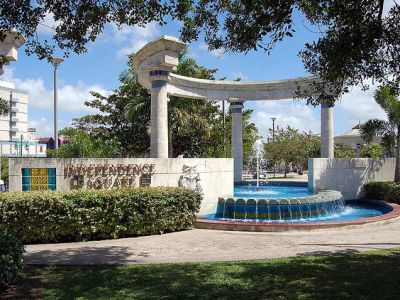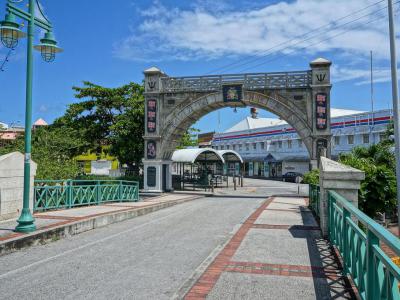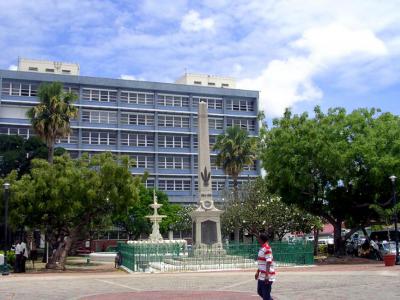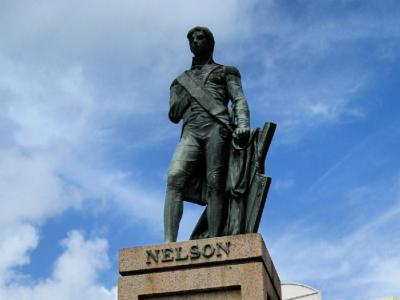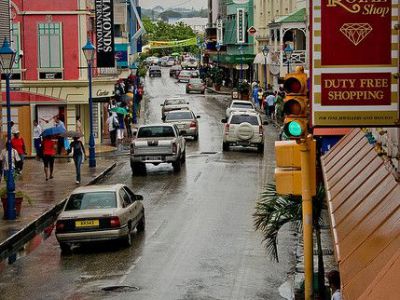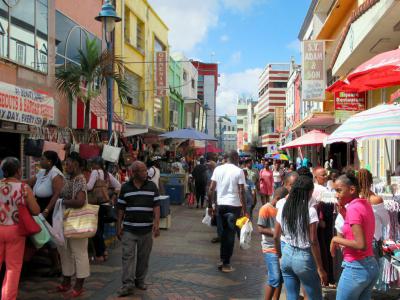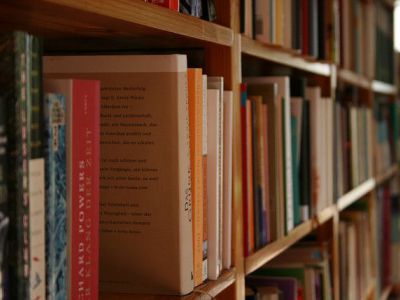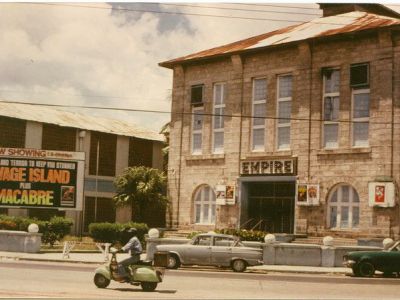Custom Walk in Bridgetown, Barbados by mariap1955_da765 created on 2024-11-27
Guide Location: Barbados » Bridgetown
Guide Type: Custom Walk
# of Sights: 8
Tour Duration: 1 Hour(s)
Travel Distance: 1.6 Km or 1 Miles
Share Key: 2ZQ6K
Guide Type: Custom Walk
# of Sights: 8
Tour Duration: 1 Hour(s)
Travel Distance: 1.6 Km or 1 Miles
Share Key: 2ZQ6K
How It Works
Please retrieve this walk in the GPSmyCity app. Once done, the app will guide you from one tour stop to the next as if you had a personal tour guide. If you created the walk on this website or come to the page via a link, please follow the instructions below to retrieve the walk in the app.
Retrieve This Walk in App
Step 1. Download the app "GPSmyCity: Walks in 1K+ Cities" on Apple App Store or Google Play Store.
Step 2. In the GPSmyCity app, download(or launch) the guide "Bridgetown Map and Walking Tours".
Step 3. Tap the menu button located at upper right corner of the "Walks" screen and select "Retrieve custom walk". Enter the share key: 2ZQ6K
1) Independence Square
Independence Square, situated on the waterfront in the heart of Bridgetown, offers a serene environment to relax and absorb the city's historic ambiance. Visitors can rest on benches lining the waterfront, providing picturesque views of notable landmarks such as the Parliament Buildings and National Heroes Square.
At the western end of the square, local vendors display crafts and offer light refreshments on the bridge, presenting an opportunity to purchase unique souvenirs. Adjacent to this area stands the Independence Arch, gracefully spanning the Chamberlain Bridge and serving as a symbolic gateway into the square.
To the west, the wooden Bridgetown boardwalk traces the waterfront, inviting strolls along its path. Independence Square itself is adorned with an amphitheater, two large fountains, intricate paving mosaics, and a statue honoring National Hero, the Right Excellent Errol Walton Barrow. Notably, during November, which marks Barbados' independence celebrations, the square is illuminated in the national colors of blue and gold. The festive decor continues into the Christmas season, with numerous illuminated Christmas trees enhancing the square's charm.
Originally one of Bridgetown's busiest car parks, Independence Square was redesigned and reopened to the public in 2007. Today, it serves as a recreational haven, featuring stone benches, mature trees providing ample shade, and a tranquil view of the river with boats gently bobbing on the water. The prominent statue of Errol Walton Barrow stands at the center, gazing across the river toward National Heroes Square.
Whether visiting during the vibrant independence festivities or at another time of year, Independence Square offers a blend of historical significance and contemporary leisure, making it a must-visit destination in Bridgetown.
At the western end of the square, local vendors display crafts and offer light refreshments on the bridge, presenting an opportunity to purchase unique souvenirs. Adjacent to this area stands the Independence Arch, gracefully spanning the Chamberlain Bridge and serving as a symbolic gateway into the square.
To the west, the wooden Bridgetown boardwalk traces the waterfront, inviting strolls along its path. Independence Square itself is adorned with an amphitheater, two large fountains, intricate paving mosaics, and a statue honoring National Hero, the Right Excellent Errol Walton Barrow. Notably, during November, which marks Barbados' independence celebrations, the square is illuminated in the national colors of blue and gold. The festive decor continues into the Christmas season, with numerous illuminated Christmas trees enhancing the square's charm.
Originally one of Bridgetown's busiest car parks, Independence Square was redesigned and reopened to the public in 2007. Today, it serves as a recreational haven, featuring stone benches, mature trees providing ample shade, and a tranquil view of the river with boats gently bobbing on the water. The prominent statue of Errol Walton Barrow stands at the center, gazing across the river toward National Heroes Square.
Whether visiting during the vibrant independence festivities or at another time of year, Independence Square offers a blend of historical significance and contemporary leisure, making it a must-visit destination in Bridgetown.
2) Independence Arch and Chamberlain Bridge
The Independence Arch stands proudly at the southern end of the Chamberlain Bridge in Bridgetown, serving as a lasting tribute to the nation's journey to self-governance. Erected in 1987 to commemorate Barbados' 21st anniversary of independence, the arch celebrates the island’s rich heritage and culture.
Adorned with key national symbols, the arch's pillars feature the flying fish and the pelican-two emblems of Barbadian identity-alongside the Pride of Barbados flower. The arch is crowned with the Coat of Arms of Barbados, which bears the national motto, “Pride and Industry”. At its base, visitors can find the National Pledge, a poignant reminder of the island’s values. Each November 30th, for Independence Day, the arch lights up in Barbados' national colors, blue and gold. Nearby, Independence Square offers a peaceful retreat from the city's hustle.
The Chamberlain Bridge, located in the heart of Bridgetown, has long been an essential crossing over the Careenage (Constitution River) at Carlisle Bay. Originally built as a swing bridge in 1872, it was named after Joseph Chamberlain (1836–1914), the British Colonial Secretary who helped secure funding for its reconstruction following the Great Hurricane of 1898. Over a century later, in 2005–2006, the outdated steel structure was dismantled and replaced with a modern lifting bridge featuring a single-leaf bascule design. Constructed from fiber-reinforced plastic (FRP), the new bridge is lighter, non-corrosive, and built to last.
Together, the Independence Arch and Chamberlain Bridge stand as enduring symbols of Barbados' history, resilience, and national pride, seamlessly blending tradition with modern engineering in the heart of the island’s capital.
Adorned with key national symbols, the arch's pillars feature the flying fish and the pelican-two emblems of Barbadian identity-alongside the Pride of Barbados flower. The arch is crowned with the Coat of Arms of Barbados, which bears the national motto, “Pride and Industry”. At its base, visitors can find the National Pledge, a poignant reminder of the island’s values. Each November 30th, for Independence Day, the arch lights up in Barbados' national colors, blue and gold. Nearby, Independence Square offers a peaceful retreat from the city's hustle.
The Chamberlain Bridge, located in the heart of Bridgetown, has long been an essential crossing over the Careenage (Constitution River) at Carlisle Bay. Originally built as a swing bridge in 1872, it was named after Joseph Chamberlain (1836–1914), the British Colonial Secretary who helped secure funding for its reconstruction following the Great Hurricane of 1898. Over a century later, in 2005–2006, the outdated steel structure was dismantled and replaced with a modern lifting bridge featuring a single-leaf bascule design. Constructed from fiber-reinforced plastic (FRP), the new bridge is lighter, non-corrosive, and built to last.
Together, the Independence Arch and Chamberlain Bridge stand as enduring symbols of Barbados' history, resilience, and national pride, seamlessly blending tradition with modern engineering in the heart of the island’s capital.
3) National Heroes Square
Located between Upper Broad Street, The Wharf Road, and the Careenage, National Heroes Square is one of the centerpieces of Bridgetown. Before 1998, the square was called Trafalgar Square.
The square is dedicated to the Order of National Heroes, and National Heroes Day is celebrated on April 28. On the first commemoration of the day, Trafalgar Square was renamed for the Order. Only 11 people have made the list of National Heroes and have been given the title "The Right Excellent." Of the people on the list, only Sir Garfield Sobers, a former cricketer, and Rhianna, a singer and businesswoman, are alive today.
However, the most prominent statues in the square have been around longer than the Order. The first one to catch your eye is undoubtedly that of Lord Nelson, the famous British Royal Navy Admiral. The statue has stood here since 1813 as a memorial to the Royal Navy's victory in the Battle of Trafalgar.
This statue was dedicated 27 years before the statue of Nelson that stands over Trafalgar Square in London. Nelson's statue here has served as the geographic center for the island since it was erected. Distances have always been measured from the statue.
Other large monuments in the square include the Cenotaph War Memorial and Fountain Gardens. A large fountain commemorates the piping of water into town in 1865.
With its location at the center of town, the square is a great place to spot other attractions. You can see the Barbados Parliament Buildings, the Department of Inland Revenue, and the Chamberlain Bridge.
The square is dedicated to the Order of National Heroes, and National Heroes Day is celebrated on April 28. On the first commemoration of the day, Trafalgar Square was renamed for the Order. Only 11 people have made the list of National Heroes and have been given the title "The Right Excellent." Of the people on the list, only Sir Garfield Sobers, a former cricketer, and Rhianna, a singer and businesswoman, are alive today.
However, the most prominent statues in the square have been around longer than the Order. The first one to catch your eye is undoubtedly that of Lord Nelson, the famous British Royal Navy Admiral. The statue has stood here since 1813 as a memorial to the Royal Navy's victory in the Battle of Trafalgar.
This statue was dedicated 27 years before the statue of Nelson that stands over Trafalgar Square in London. Nelson's statue here has served as the geographic center for the island since it was erected. Distances have always been measured from the statue.
Other large monuments in the square include the Cenotaph War Memorial and Fountain Gardens. A large fountain commemorates the piping of water into town in 1865.
With its location at the center of town, the square is a great place to spot other attractions. You can see the Barbados Parliament Buildings, the Department of Inland Revenue, and the Chamberlain Bridge.
4) Statue of Lord Horatio Nelson
The bronze statue of British naval officer Horatio Nelson, 1st Viscount Nelson, stood in National Heroes Square (formerly Trafalgar Square) in Bridgetown, from 1813 until its removal in 2020. The statue, created by sculptor Richard Westmacott, was erected on 22 March 1813 in honor of Nelson’s 1805 visit to Barbados, during which he and the British fleet pursued the Franco-Spanish navy ahead of the decisive Battle of Trafalgar.
For much of its existence, the monument was a significant landmark in Bridgetown, with the adjacent Parliament Buildings constructed later in the 19th century. It was even featured on Barbadian postage stamps between 1906 and 1964. However, its role as a colonial symbol became increasingly contentious. In 1999, Trafalgar Square was renamed National Heroes Square, reflecting Barbados’ evolving historical narrative. Official tributes to Nelson declined, and by 2017, public opposition became more pronounced-vandals covered the statue in blue and yellow paint on the eve of the nation’s Independence Day, branding Nelson as a "racist and white supremacist."
On 24 July 2020, John King, the Minister responsible for Culture, announced plans to remove the statue during the national Season of Emancipation. Delays pushed the relocation to 16 November 2020, the International Day for Tolerance. The statue was ultimately transferred to the Barbados Museum, marking a shift in how the nation commemorates its past.
For much of its existence, the monument was a significant landmark in Bridgetown, with the adjacent Parliament Buildings constructed later in the 19th century. It was even featured on Barbadian postage stamps between 1906 and 1964. However, its role as a colonial symbol became increasingly contentious. In 1999, Trafalgar Square was renamed National Heroes Square, reflecting Barbados’ evolving historical narrative. Official tributes to Nelson declined, and by 2017, public opposition became more pronounced-vandals covered the statue in blue and yellow paint on the eve of the nation’s Independence Day, branding Nelson as a "racist and white supremacist."
On 24 July 2020, John King, the Minister responsible for Culture, announced plans to remove the statue during the national Season of Emancipation. Delays pushed the relocation to 16 November 2020, the International Day for Tolerance. The statue was ultimately transferred to the Barbados Museum, marking a shift in how the nation commemorates its past.
5) Broad Street
Located in the heart of Bridgetown, Broad Street serves as the city’s central commercial artery, bustling with activity and rich in history. This prominent thoroughfare is the epicenter of shopping, finance, and dining, making it a prime destination for both locals and visitors.
Historically, Broad Street was once part of a longer and narrower street known as Cheapside. Today, Cheapside lies at the western end of the city, home to the General Post Office and Cheapside Market. Broad Street itself has evolved into a vibrant commercial hub, drawing in shoppers with its array of duty-free stores, high-end jewelry boutiques, and major department stores. Well-known retailers such as Cave Shepherd & Company, Harrisons, Diamonds International, Colombian Emeralds, and Little Switzerland line the street, offering everything from luxury goods to everyday essentials.
In addition to its reputation as a shopping destination, Broad Street houses several key financial institutions. Major commercial banks, including the Royal Bank of Canada, Republic Bank of Trinidad and Tobago, FirstCaribbean International Bank Ltd, Barbados National Bank Ltd, Bank of Nova Scotia, and Butterfield Bank, have their main branches here. The presence of these institutions solidifies Broad Street’s role as a financial hub in the capital city.
Broad Street is also an architectural showcase, featuring a mix of modern and historic buildings. It is divided into Upper and Lower Broad Street, with Upper Broad Street near the well-known Lord Nelson Statue and Lower Broad Street situated near the Old Mutual Building, an architectural landmark that now houses a branch of Butterfield Bank. The street stretches from Saint Mary’s Church and the Old Town Hall on its western side to Bridge Street, close to National Heroes Square and the Parliament Buildings. Running parallel to Constitution River, it offers easy access to harbor cruises and boat rides along the waterfront.
A hive of daily activity, Broad Street is particularly popular among tourists, many of whom arrive from the nearby cruise ship port. However, visitors should note that most shops close on Sundays. Despite this, the street remains an essential part of the Bridgetown experience, offering a seamless blend of commerce, history, and vibrant city life.
Historically, Broad Street was once part of a longer and narrower street known as Cheapside. Today, Cheapside lies at the western end of the city, home to the General Post Office and Cheapside Market. Broad Street itself has evolved into a vibrant commercial hub, drawing in shoppers with its array of duty-free stores, high-end jewelry boutiques, and major department stores. Well-known retailers such as Cave Shepherd & Company, Harrisons, Diamonds International, Colombian Emeralds, and Little Switzerland line the street, offering everything from luxury goods to everyday essentials.
In addition to its reputation as a shopping destination, Broad Street houses several key financial institutions. Major commercial banks, including the Royal Bank of Canada, Republic Bank of Trinidad and Tobago, FirstCaribbean International Bank Ltd, Barbados National Bank Ltd, Bank of Nova Scotia, and Butterfield Bank, have their main branches here. The presence of these institutions solidifies Broad Street’s role as a financial hub in the capital city.
Broad Street is also an architectural showcase, featuring a mix of modern and historic buildings. It is divided into Upper and Lower Broad Street, with Upper Broad Street near the well-known Lord Nelson Statue and Lower Broad Street situated near the Old Mutual Building, an architectural landmark that now houses a branch of Butterfield Bank. The street stretches from Saint Mary’s Church and the Old Town Hall on its western side to Bridge Street, close to National Heroes Square and the Parliament Buildings. Running parallel to Constitution River, it offers easy access to harbor cruises and boat rides along the waterfront.
A hive of daily activity, Broad Street is particularly popular among tourists, many of whom arrive from the nearby cruise ship port. However, visitors should note that most shops close on Sundays. Despite this, the street remains an essential part of the Bridgetown experience, offering a seamless blend of commerce, history, and vibrant city life.
6) Swan Street
Swan Street parallels Broad Street to the north. It's a narrow alleyway of a street lined with shops and restaurants. It's pedestrian-only, so while it can be quite crowded, it's a great place to wander to meet the locals. There are several electronics stores, home goods, a shopping mall, and takeaway restaurants.
The buildings on Swan Street are traditional homes, with the businesses built on the lower levels. At one time, the street was known as Jew's Street because of the community's successful Jewish merchants. Many of the shopkeepers lived in the upper stories of the buildings. Unfortunately, a major fire swept through the area in 1845. After which, the street was part of what the locals dubbed the Burnt District.
Today, you'll see businesses and haberdasheries from around the world here. But the upper levels are no longer homes. Instead, they are mostly used as warehouses now.
Historians are unsure how the street got its official name. Some suggest that there was an inn named The Swan. Others say it was s tribute to a local surveyor, Captain Swan.
It's a busy place, favored by the locals more than the tourists. Swan Street is a must-see if you're looking for island goods and good prices. This street keeps the Barbadian spirit alive--you can find everything here, from fresh fruit and veggies to local island jewelry and crafts.
The buildings on Swan Street are traditional homes, with the businesses built on the lower levels. At one time, the street was known as Jew's Street because of the community's successful Jewish merchants. Many of the shopkeepers lived in the upper stories of the buildings. Unfortunately, a major fire swept through the area in 1845. After which, the street was part of what the locals dubbed the Burnt District.
Today, you'll see businesses and haberdasheries from around the world here. But the upper levels are no longer homes. Instead, they are mostly used as warehouses now.
Historians are unsure how the street got its official name. Some suggest that there was an inn named The Swan. Others say it was s tribute to a local surveyor, Captain Swan.
It's a busy place, favored by the locals more than the tourists. Swan Street is a must-see if you're looking for island goods and good prices. This street keeps the Barbadian spirit alive--you can find everything here, from fresh fruit and veggies to local island jewelry and crafts.
7) Barbados Central Public Library
The Barbados Central Public Library, historically known as the Carnegie Free Library, has been a cornerstone of Bridgetown’s literary and cultural landscape for over a century. Constructed between 1903 and 1906 with funding from Scottish-American philanthropist Andrew Carnegie, the library stands on Coleridge Street in an elegant English Renaissance-style coral-stone building.
As the main branch of the National Library Service of Barbados, the library housed an extensive collection of Barbadiana, preserving Barbados' historical and literary heritage dating back to the 18th century. Beyond its role as a repository of knowledge, the library has served as an essential community space, offering print and non-print resources to both locals and visitors.
After a century of continuous service, the Carnegie Free Library closed in August 2006 for much-needed renovations. In the interim, its operations were relocated to Independence Square. The restoration of the original building has since become a priority project for the Preservation (Barbados) Foundation Trust, a non-profit initiative under the Ministry of Youth, Sports, and Culture. The Trust, working alongside a National Heritage Task Force, is spearheading efforts to secure funding and ensure the library’s return to its historic home.
The National Library Service, which oversees this and seven other branches across the island, remains under the Prime Minister’s Office, ensuring continued public access to information and educational resources. Once fully restored, the Barbados Central Public Library is expected to reclaim its place as a beacon of literacy, history, and community engagement in Bridgetown.
As the main branch of the National Library Service of Barbados, the library housed an extensive collection of Barbadiana, preserving Barbados' historical and literary heritage dating back to the 18th century. Beyond its role as a repository of knowledge, the library has served as an essential community space, offering print and non-print resources to both locals and visitors.
After a century of continuous service, the Carnegie Free Library closed in August 2006 for much-needed renovations. In the interim, its operations were relocated to Independence Square. The restoration of the original building has since become a priority project for the Preservation (Barbados) Foundation Trust, a non-profit initiative under the Ministry of Youth, Sports, and Culture. The Trust, working alongside a National Heritage Task Force, is spearheading efforts to secure funding and ensure the library’s return to its historic home.
The National Library Service, which oversees this and seven other branches across the island, remains under the Prime Minister’s Office, ensuring continued public access to information and educational resources. Once fully restored, the Barbados Central Public Library is expected to reclaim its place as a beacon of literacy, history, and community engagement in Bridgetown.
8) Empire Theater
The Empire Theater holds a significant place in Bridgetown’s cultural history as the first venue in the city to showcase motion pictures. Opened in 1922, the theater originally functioned as both a live performance space and a cinema, becoming a vital entertainment hub for decades. Designed in Colonial Revival style, its 859-seat, single-screen auditorium stood as a premier venue for film and stage performances alike.
Before transitioning into a cinema, the Empire Theater hosted vaudeville shows, dance performances, and comedy acts, adapting over time to sustain its operations. Among the many who graced its stage was Frank Collymore, the celebrated Barbadian writer and performer, adding to the theater’s local artistic legacy. By the mid-1940s, ownership had shifted to the British Colonial Film Exchange, solidifying its place as a key player in Barbados’ entertainment scene.
However, despite its early prestige, the Empire Theater closed around 1975, having fallen victim to changing entertainment trends and economic challenges. Since then, the building has stood derelict, a shadow of its former self, yet still hinting at the grandeur it once possessed. For many Barbadians, it remains a nostalgic landmark, evoking memories of kung fu movie screenings and nights spent enjoying live performances.
Recognizing its cultural and architectural value, various Barbadian administrations have proposed restoration efforts, with a notable plan in 2003 to transform it into a home for the national performing arts company.
Before transitioning into a cinema, the Empire Theater hosted vaudeville shows, dance performances, and comedy acts, adapting over time to sustain its operations. Among the many who graced its stage was Frank Collymore, the celebrated Barbadian writer and performer, adding to the theater’s local artistic legacy. By the mid-1940s, ownership had shifted to the British Colonial Film Exchange, solidifying its place as a key player in Barbados’ entertainment scene.
However, despite its early prestige, the Empire Theater closed around 1975, having fallen victim to changing entertainment trends and economic challenges. Since then, the building has stood derelict, a shadow of its former self, yet still hinting at the grandeur it once possessed. For many Barbadians, it remains a nostalgic landmark, evoking memories of kung fu movie screenings and nights spent enjoying live performances.
Recognizing its cultural and architectural value, various Barbadian administrations have proposed restoration efforts, with a notable plan in 2003 to transform it into a home for the national performing arts company.
